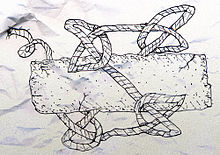- Druid's bend
-
The Druid's Bend, also known as The Celtic's Bend, is a celtic knot, dating from antiquity, which might have been used to secure and haul the stones that constitute Stonehenge.
 An example of a Celtic Bend tied about a stone pillar.[dubious ]
An example of a Celtic Bend tied about a stone pillar.[dubious ]
In the style of the celtic knot motif, the Druid's Bend is interlocking and ornate, yet has incredible tensile strength upon repeated tension cycles. Similar in purpose to the timber hitch, it is designed to minimize kinetic friction, making it ideal for dragging heavy objects long distances. But unlike similar hitches, its mesh-like web evenly distributes tension, allowing it to tenderly cradle minerals as they move across earth.
Significance
J. Romilly Allen has identified "eight elementary knots which form the basis of nearly all the interlaced patterns in Celtic decorative art"[1][2]; however, there is no evidence to indicate that a knot had any specific philosophical or religious significance beyond perhaps the most obvious, that being the intricacy capable in the work of humans, itself reflective of the intricacy of Natural forms.[citation needed] Many items decorated with knotwork have been found in archaeological sites. In Celtic prehistory, quarries were often far away from astronomical sites, and the Druid's Bend was a practical, yet spiritually acceptable variant knot that was widely adopted for a range of hauling needs.
Tying
The Druid's Bend is quickly learned but requires a large quantity of rope, string, or other binding fiber. A simple rule of thumb to determine the amount of rope needed is governed by the diameter of the cylinder cubed.
References
- ^ J. Romilly Allen (1933). Celtic Art in Pagan and Christian Times. Studio Editions Ltd. ISBN 1-85891-075-7.
- ^ Drew Ivan (2005-08-10). "Eight Basic Knotwork Patterns". http://www.thinkythings.org/knotwork/jra-knots.html. Retrieved 2007-01-10.
Categories:- Knots
- Celtic art
Wikimedia Foundation. 2010.
